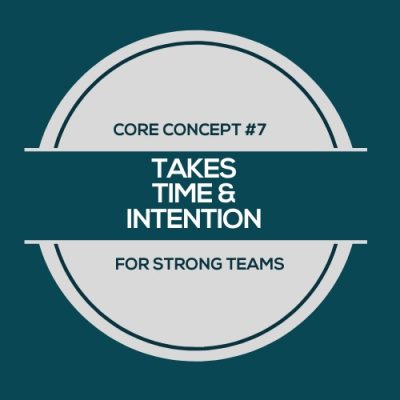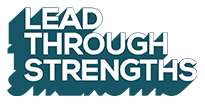How To Develop Your Strengths At Work: Time And Intention
Podcast: Play in new window
Subscribe: Spotify | iHeartRadio | Email | TuneIn | More

How To Develop Your Strengths At Work
As in any growth process, patience is a virtue. If you're looking at how to develop your strengths at work, there's good news: you can boost strengths by applying them to any of the work that you already have on your plate.
Let’s break this core concept down to its two components.
1. Strengths Take Time: (How To Develop Your Strengths At Work)
Between the two components (time and intention), time is generally the easier one to commit to. It may mean a little bit of being patient, but the concept is more about asking:
“Now what?”
“How do we keep this going?”
"How can we remember to apply CliftonStrengths in our everyday work?"
"What are ways to develop your strengths at work without adding a bunch of work?"
After the first strengths blitz you do with your team -- for example, going through the first step of reading “StrengthsFinder 2.0,” or preparing a budget for a team offsite and then getting together for a retreat or some team building activities -- ultimately, what do you do with all of that? How do you connect your natural strengths once you’re back to the grind?
While team activities do a lot to help you learn about each other, the questions remain: What’s next? How do we apply we’ve learned? How to develop strengths at work without making it feel like we've taken on a second job?"
It all boils down to taking consistent effort towards strengths over time. When people ask how to apply StrengthsFinder after the initial strengths discovery training, they usually realize it's a process. You might have the raw talent, but it has to develop over time to turn into a towering strength. This includes breaking old thinking patterns in order to adopt new and better ones. For example, if many on your team are lopsidedly obsessed with weakness-fixing, it will take consistent effort to orient your minds to have a strengths-focus.
The best thing we can recommend is to have meaningful conversations with your team over time. And to achieve meaningful conversations, that takes a lot of trust between a manager and the team members. Full trust and openness won't happen overnight, so that's part of the time equation. The other part of the time equation is that human development can be like a steady trend line - up and to the right. It's not a spike where you're at 5% of your strengths-potential today and you're at 100% the day after the virtual team building event (wouldn't that be awesome?!).
CliftonStrengths As A Way To Develop Your Strengths At Work, Without Doing More Work
Here at Lead Through Strengths, the way we help patience come into effect is by making it a way of thinking rather than just generic words of encouragement. Instead of telling teams to “be patient, it will happen if we give strengths a bunch of time and effort,” we prefer for them to think of strengths as the way they can get any results more easily. Think of it as a way to do the work you're already doing rather than a way to add more work.
To illustrate this concept further, if you're using your natural talents and you've been developing them into strengths, you should be able to apply them to the outcomes you're already focused on. It shouldn't feel like strengths is so much of an initiative or an event or an extra thing on your plate that’s already full, but rather something like —
"I can lend my strengths to the work I already have to do."
When you're constantly busy and overbooked, you wouldn't want to view strengths as an extra task to have to manage. You would be more stoked about it if you could lend your strengths to the work that’s currently on your plate.
It's about meaningful conversations over time. Ultimately, when your understanding about each other deepens, trust is built and you collaborate better. That’s how you can honor their talents so that they can be effectively applied at work.
Remember: Think of patience more like how you do the work you're already doing to easily achieve results versus seeing it as another item on your plate. That makes a strengths implementation more effective.
2. Strengths Demand Intention: (How To Develop Your Strengths At Work)
If time is the easier component in this concept, intention is the bigger one. As human beings, we have a number of cognitive biases, including negative cognitive biases. Let’s skip the fancy psychology terminology by looking at it this way -- if we are naturally oriented to spot what's negative, that's usually because we're trying to figure out what will hurt us. For example, we might subconsciously be scanning for:
“What weakness do I need to shore up?”
“What do I need to improve at so that I don't get fired over it?”
“Where do I need to shut up in a meeting because otherwise, a) it might endanger my job, and b) I might disappoint my teammates who might think I’m not being a good collaborator.”
"What are ways to develop your strengths at work, but to also be sure that you're squashing out all of the weaknesses that pop up?"
These are just some of the reasons we are drawn towards this negative cognitive bias. It's not all bad. This bias can keep us safe. But it can also become a lopsided obsession. We don't believe that weaknesses should be ignored, yet they don't always have to be addressed.
For example, people will tell me that they have a weakness in Adaptability, yet their role doesn't call on that talent. In that case, if it's not getting in the way of your performance or the performance of a colleague, we mark it off of the weakness list. As you look for ways to develop your strengths at work, you have a lot of weakness-fixing thoughts to compete with. Those competing thoughts can keep you from prioritizing your intention to develop in your greatest area of potential.
The problem arises when we become so focused on weaknesses that we forget how efficient and effective it is to use our strengths. That’s where the idea of leading through strengths becomes powerful, because it gives you a totally different result when you’re working within your strengths zone.
What Happens When We're Implementing StrengthsFinder With Full Leverage?
When we think of strengths as a tool that we could use, like the "Easy Buttons" we talked about in Concept #4, that can unlock some real performance gains that people are missing out on.
Have you ever tried to pull a nail out with the back of the hammer and you don't have the lever in the right place because you can't get it up in there all the way? Because you're not pulling against the strong lever, you exert more effort to get the nail out so it bends it all sideways and messes up the material you're pulling it out of. That's what it’s like when you're working in your weakness zone.
But when you're working in your strengths zone, you get the full leverage. You exert less effort to get better results. You get that kind of satisfying feeling when it happens. It's the same with using your strengths at work. It's like getting the lever in the right place.
Apply CliftonStrengths To Develop Your Strengths At Work
Setting time and intention means that you stay consistent as you go through the process of fully realizing your strengths, from spotting talent to developing it. We realize that it would be super cool to realize all potential immediately, yet we're human, so it takes time to grow. Since so many things are competing for our attention, it takes intention to prioritize strengths.
- Spot the potential talent when it’s happening. If you’re trying to spot your own talents, you may want to focus on your unique abilities, or those things that are easy for you to do but not for other people. Sometimes it's tough to spot talents in ourselves because you might think a talent is not a special talent because it seems like anyone can do what you just did.
- Experiment with the talent. This is the stage where you test the potential talent. Work on expanding your potential by trying new ways to apply the talent. Check what impact it can create for others by watching their responses when you offer a contribution. For example, next time something seems easy and you'd never give yourself a gold star for it - watch to see if it's appreciated or noted.
Often you'll find that you're helping the team out, and it would have been a much heavier lift for them. For example, next time someone says, "I really like how you visualized the data there" or "I loved that PPT design," offer the template to your teammate who would have to spend hours trying to make something similar.
- Apply the talent. Look for places and opportunities where you could offer your talents and be seen as a valued contribution. Keep one talent in mind, and ask yourself (over and over) how you could use it. A great way to do this is to pick one of your 34 StrengthsFinder talent themes and set an intention to grow in that area this month. Put it as a locks screen on your phone. We even made lock screen images for you to make it easy. That way, you'll remind yourself...oh 157 times per day as you unlock your phone...to focus on that talent.
For example, you can apply Learner by being an early adopter of change. You can also apply it by nerding out on some research and sharing the synopsis with a team. You and also apply Learner by being curious and asking great questions in a meeting. There are dozens of different ways to apply each talent if you get creative.
- Develop the talent. When developing your talent, have the mindset that if you can achieve more with less effort, you can get better results in the same amount of time. Then you might be inspired to double down on it and develop further so you can offer an even bigger contribution. If you're drawing a blank on how to apply and develop your talent, take a look at your CliftonStrengths talent pages. Near the bottom, there are ideas to get you started.
This whole process of seeing the talent, experimenting with it, applying it, and then developing it further may sound like an easy cycle to do, but it takes time, intention and thought. You probably have a busy schedule and you're not looking for a bunch of new to-dos.
So if you're strapped for time, focus more on the intention part of things. You don't have to spend a lot of minutes on this. Develop your strengths at work by applying them to work you're already required to do.
It's more about a lens to look through - but you can't see through the lens if you don't take a second to put the glasses on.
How To Apply StrengthsFinder To A Strengths-Based Culture
At the introduction of this series, we mentioned a 3-coin challenge that can help get you in the habit of noticing what works in each of your team members so that you get more of what works.
The beauty about doing that as a team, especially if you do it consistently with time and intention and it works well, is that you get to start a culture in your company. That would be the culture where,
- You are oriented to each other in a way that favors strengths, you call it out and notice it in each other
- You are mindful enough to recognize what the person is trying to contribute so that when they do and you see it, you realize:
“Oh, yeah, that really was effective. I wouldn't have noticed it otherwise because I would have been too busy to notice while my face was buried in my laptop all day.”
A tiny subculture of 10 people (or whatever size of direct reports you have) is powerful enough to start the snowball effect for a whole department or organization. A team culture is even more powerful than the overall company culture. If you try to manage or direct an organizational culture - as the different departments, founders, leaders, and variations come into play - it can get pretty complex. But if you are a team where you all work closely and learn about each other day in and day out, that's a culture you can powerfully impact through your strengths.
So, Now What?
Have meaningful conversations with your team over time, and the ways to develop your strengths at work will become more obvious. And bonus! Conversations are also less expensive than off site meetings. It also allows some breathing room for the strengths (and trust) to fully develop instead of cramming them all in at once.
This idea of how to develop your strengths at work is simple, but not easy. It's like being great at your personal health. You might have action ideas for your nutrition and fitness, but you don't consistently do them. Same with the strengths (mental) gym. If you take tiny actions over time, you'll uncover tons of ways to develop your strengths at work.
Ready For The Next S.T.R.E.N.G.T.H.S. Core Concept?
The 9 Concepts:
Carmie is a professional writer and editor at Lead Through Strengths. Having spent 8 happy years with a nonprofit child organization as a storyteller and sponsorship relations team manager, she continues collaborating with others across the globe for the joy of human development and connection. Her days are powered by coffee, curiosities, cameras (film and digital), music, notebooks, and a cat. Where books are home, she’s home. She calls her Top 5 StrengthsFinder Talents “CLIPS” (Connectedness, Learner, Intellection, Positivity, and Strategic)–you know, those tiny objects that hold connected things together. She’d like to think she’s one.

